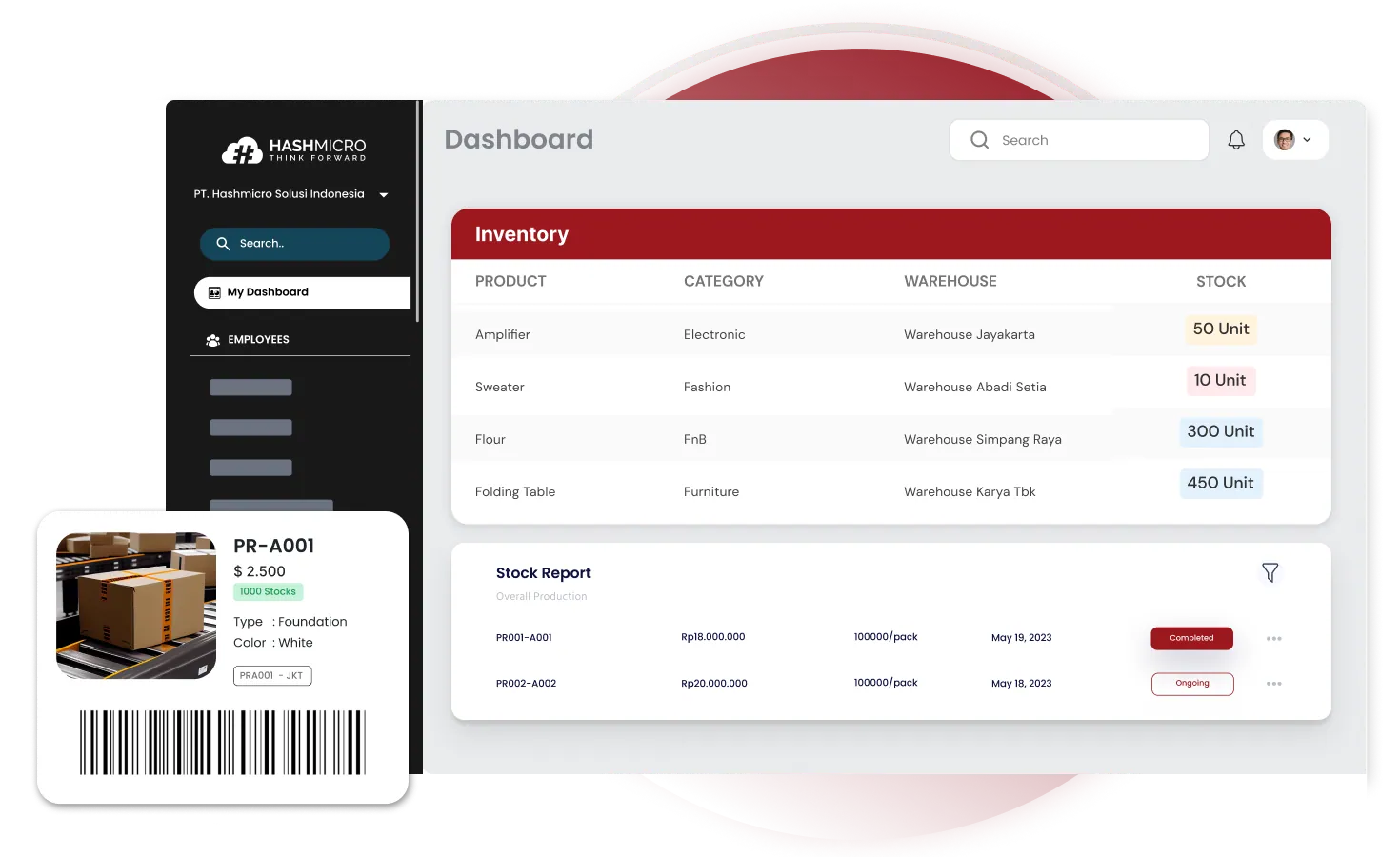Physical inventory is the process of verifying that actual stock levels match what’s recorded in your system. If left unchecked, discrepancies can lead to financial losses and operational issues, but regular physical counts help maintain accuracy and prevent costly mistakes.
Not only do they help you get a clear and accurate picture of your inventory, but they can also significantly cut down on inventory carrying costs, which research shows can reach 30-60% of your inventory’s value. By accounting for every item, you’re not just preventing errors—you’re also saving money.
This article will cover everything you need to know about conducting physical inventory counts, including the steps, methods, processes, planning, and benefits involved.

Key Takeaways
|
What is Physical Inventory?
Physical inventory is a stock-taking method in which retail staff manually count store inventory and adjust their inventory management system if they find discrepancies.
A physical inventory begins with tallying up stock in your store, from the sales floor to the back room. You’ll then match these counts with what’s recorded in your POS system and resolve any differences.
Steps in physical inventory:
- Count stock items manually.
- Compare with POS system records.
- Identify discrepancies and update records.
- Analyze shrinkage rate and take corrective action.
Types of Physical Inventory
There are several methods to conduct a physical inventory, each with its own advantages and challenges. Here are the main types you can consider:
1. Manual counting
A manual inventory count is exactly what it sounds like. Store associates count each item by hand in the stockroom and on the sales floor, recording the numbers with pen and paper.
While this method is low-cost, it’s time-consuming and highly prone to human error, which is why most stores steer clear of it.
- Advantage: This method is more cost-effective because it doesn’t require any special equipment.
- Disadvantage: However, it is prone to human error, making it less reliable.
2. Electronic counting
An electronic inventory count involves using barcode scanners and a POS system to speed up the process and improve accuracy. As each item is scanned, the SKU’s inventory level is updated electronically.
This method significantly reduces the chances of over- or under-counting and creates a digital record for easy reconciliation against POS data.
- Advantages: Electronic counting lowers the risk of over- or under-counting, leading to more accurate inventory records.
- Disadvantages: Despite its accuracy, this method can still be time-consuming and requires staff to complete.
3. Cycle counting
Cycle counts, or partial inventory counts, focus on counting specific categories of products rather than the entire store’s inventory. This method is perfect for retailers who want to keep accurate records while saving time by breaking the task into smaller, more manageable parts.
Unlike full counts, inventory cycle count for accuracy can usually be done during regular business hours without closing the store.
- Advantages: Cycle counting can be done during regular work hours and is less time-intensive, making it more convenient.
- Disadvantage: It is not easily scalable for growing businesses with increasing inventory.
4. Full inventory counting
A full inventory count typically takes place at the end of the year, after the holiday season, when stock levels are at their lowest. Retail teams tally up all the inventory in the store, ensuring they start the new year with accurate records that reflect the total cost of goods sold and the retail value of merchandise.
Given the time and effort required, many small retailers limit full counts to once or twice a year, opting for cycle counts in between.
- Advantage: Full inventory counting provides highly accurate inventory numbers, which are essential for preparing balance sheets.
- Disadvantages: This method often requires the store to close temporarily and is labor-intensive
Below are the comparison table between those four types of physicial inventory:
| Types | Definition | Advantage | Disadvantage |
| Manual counting | Count each item by hand in the stockroom and recording the numbers with pen and paper. | Cost-effective | Prone to human error |
| Electronic counting | Using barcode scanners and a POS system to speed up the process and improve accuracy | Lowers the risk of over- or under-counting | Time-consuming and requires staff to complete |
| Cycle counting | Counting specific categories of products rather than the entire store’s inventory | Can be done during regular work hours and is less time-intensive | Not easily scalable |
| Full inventory counting | Takes place at the end of the year, after the holiday season, when stock levels are at their lowest | Highly accurate inventory numbers | Requires the store to close temporarily and is labor-intensive |
Benefits of Physical Inventory Count

Conducting regular physical inventory counts is essential for maintaining control over your stock. Below are some key benefits of performing these counts:
1. Maintain inventory accuracy
Regular physical inventory counts align actual stock with system records to prevent costly discrepancies. Using a cloud-based inventory automates data syncing, improving accuracy and reducing risks like loss or missed shipments.
2. Improve demand forecasting
Accurate inventory checks improve demand forecasting by showing exactly what’s in stock and when to restock. This helps you order based on both popularity and profitability, avoiding overstock or shortages.
3. Prevent stockouts
Stockouts frustrate customers and often stem from poor inventory management, but regular counts and low stock alerts can prevent them. In fact, 43% of retail associates cite out-of-stock complaints as their biggest challenge, and 39% of consumers leave stores without buying because of it.
4. Increase sell-through rate for struggling inventory
Inventory counts don’t just prevent stockouts—they also help you manage slow-moving inventory items. You can take action by identifying products that aren’t selling as expected and focusing on improving their sell-through rate. This helps move inventory faster, ensuring you get a return on your investment and free up space for more in-demand products.
5. Reduce inventory shrinkage
Inventory shrinkage, when actual stock is lower than recorded, is often caused by theft or shoplifting. Regular partial counts help detect discrepancies early, preventing unnoticed losses and inaccurate stock records.
6. Avoid over- or understocking
Poor inventory monitoring can cause overstocking or understocking, hurting profits. U.S. Census Bureau data shows retailers held $1.39 in inventory for every $1 in sales as of April 2023. Maintaining balanced stock levels prevents markdowns and protects profit margins.
When to Do a Physical Inventory Count

When restocking, it’s smart to conduct a mini-physical inventory count to ensure the total number of items, both new and existing, is accurate. This gives you a solid baseline for future inventory checks.
How often you should do a physical inventory count depends on several factors, such as:
- The number of SKUs in your inventory
- The daily sales volume
- The inventory method you’re using
- Whether you use technology like a POS system or barcode scanners
For instance, if you run a small clothing boutique with 120 SKUs, counting everything might not take long. A monthly full inventory count would be manageable. On the other hand, if you’re a large retailer with thousands of items sold daily, you might need to check stock more frequently.
Regularly counting inventory helps keep financial records accurate, prevents mistakes, and keeps customers happy. If you don’t do these counts often, you might lose money, disappoint customers with out-of-stock items, and have trouble spotting theft or loss.
In fact, 43.8% of firms with inventory-related MWIC (Material Weaknesses in Internal Controls) report inventory impairments compared to 22.3% in control firms
Still, you can speed up the process by focusing on smaller sections of your inventory (this is called a cycle count or partial inventory count).
Besides doing partial counts, it’s a good practice for merchants to perform a complete physical inventory count at least once near the end of the year. This ensures your inventory records are accurate when preparing your balance sheet for tax season.
Step-by-Step Guide to Counting Physical Inventory
Counting physical inventory requires careful planning and execution to ensure accuracy. Follow these steps to carry out your inventory count effectively:
1. Schedule and Plan the Count
Schedule your inventory count in advance and notify staff early, setting a clear date whether weekly, monthly, or quarterly. If closure is needed, inform customers through announcements and ensure enough staff are assigned to finish the count efficiently after hours.
2. Prepare and Assign SKUs
Plan your inventory count by listing all SKUs and dividing them among staff to prevent double-counting. Organize the stockroom and sales floor beforehand to ensure each team member can work efficiently.
3. Restock the Floor
Restock as much inventory as possible on the sales floor before counting to make organization and counting easier. This reduces backroom inventory, freeing up space for new products.
4. Explain the Process
Make sure all staff understand the inventory counting process and where to record results accurately. Provide training on any software used and allow only skilled employees to participate.
5. Assign Locations
Assign specific aisles or locations to each employee to streamline the counting process and ensure accuracy through cross-checking. This approach allows sections of the store to be closed gradually instead of shutting down entirely.
6. Compile and Review the Count
After completing the count, review and compare results from different employees to ensure consistency. Recount or provide training if discrepancies arise, as accurate data is vital for reordering and financial decisions.
Issues Companies May Face with Physical Inventory

While physical inventory counts are crucial, they can present several challenges for companies. Here are some common issues that businesses may encounter during the process:
1. Time and Resource Constraints
One of the biggest challenges companies face with physical inventories is the required time and resources. Many businesses find it necessary to shut down parts or even all operations to conduct a thorough inventory. This disruption can lead to poor customer service, as operations are paused during the count.
2. Limited Staff Availability
Not all companies have enough staff to complete a full physical inventory. Smaller businesses, in particular, may struggle with the manpower needed to accurately count all inventory items, making the process even more challenging.
3. Common Discrepancies in Physical Counts
Discrepancies during physical inventory counts often arise due to inaccurate recording by internal or temporary staff. Common issues include:
- Incorrect Recording: Some inventory items may be inaccurately documented or incorrectly classified, leading to mismatches in inventory records.
- New Item Errors: New inventory items might be recorded improperly, further complicating the count’s accuracy.
4. Items to Exclude from Physical Inventory
Regardless of how accurate the physical inventory count is, certain items should be excluded from the count:
- Supplier Receipts: Any supplier receipts that arrived after the predetermined cut-off date should not be included in the count.
- Known Thefts: Items that have been identified as stolen should not be counted in the inventory.
- Uninvoiced Shipments: Any shipments that have departed but do not have accompanying invoices should also be excluded from the physical inventory.
Tips and Best Practices for Physical Inventory Count
The key to a successful inventory count lies in thorough planning. Implementing a clear, detailed policy with step-by-step instructions can minimize uncertainties and make the physical inventory process smoother and more efficient.
Here are some tips to boost your team’s accuracy during the count:
- Leverage Technology: Equip your staff with scanners or other stock-counting tools to enhance precision and speed.
- Choose Attentive Counters: Select team members who are detail-oriented and focused to ensure accurate counts.
- Address Issues Quickly: If discrepancies arise, tackle them immediately to prevent errors from snowballing.
- Practice with a Mock Count: Conduct a practice run during the planning phase to iron out any potential issues before the actual count.
- Hide Cost Information: To avoid distractions and maintain focus, ensure that item costs aren’t displayed during the count.
- Pause Operations: To complete the physical inventory, stop all other business activities to allow your team to concentrate fully on the count.
- Limit Staff Presence: Only essential staff should be on-site during the count to reduce distractions and ensure everyone is focused on the task.
- Secure the Inventory Area: On the count day, ensure the stock area is secure and organized to streamline the process.
- Use Inventory Software: Incorporate inventory management software to keep everything organized and help track progress in real-time.
With these strategies in place, your inventory count will be more accurate, efficient, and less stressful for everyone involved.
“Physical inventory is essential for ensuring accurate stock records and financial reporting. Regular verification helps detect discrepancies, reduce shrinkage, and improve decision-making accuracy.”
— Angela Tan, Regional Manager
How to Streamline Physical Inventory Counts With HashMicro

Counting inventory is just part of doing business, but it doesn’t have to be a headache. Using an inventory management system like HashMicro’s helps ensure you’ve got the right stock in the right places to meet customer demand without stress.
HashMicro’s Inventory Count feature gives you more control over your assets. You can categorize inventory based on transaction volume or value and make regular counts to keep everything accurate. Additionally, the system is integrated with Barcode & QR Codes and RFID technology, so companies have an easier time counting their inventory accurately.
With HashMicro, you get accurate inventory levels, automated prompts for what needs counting, and improved quality assurance—all leading to happier customers. Plus, as you cycle count, discrepancies get smaller and smaller, making reconciliation a breeze.
Want to see how it works? Give HashMicro a try with a free demo! You’ll see just how much easier inventory management can be.
Warning: Undefined array key "med" in /home/hashmicr/public_html/blog/wp-content/plugins/insert-headers-and-footers/includes/class-wpcode-snippet-execute.php(419) : eval()'d code on line 281

FAQ About Physical Inventory
-
How to calculate physical inventory?
Staff are assigned maps, inventory printouts, and equipment before counting the designated inventory. After recording the data on spreadsheets or count tags, they return the completed documents to managers, who then input the collected information into the inventory system.
-
When is a physical inventory usually taken?
Physical inventories are typically conducted when there is minimal activity in terms of goods being sold or received, and often at the close of a company’s fiscal year.
-
What is the key to a good physical inventory?
Before starting the physical count, plan the warehouse layout, assign bin locations to teams, and remove damaged or RTV items to ensure accurate results.
-
Who is responsible for inventory count?
The inventory manager oversees inventory control, but effective management requires teamwork across all staff levels.






























